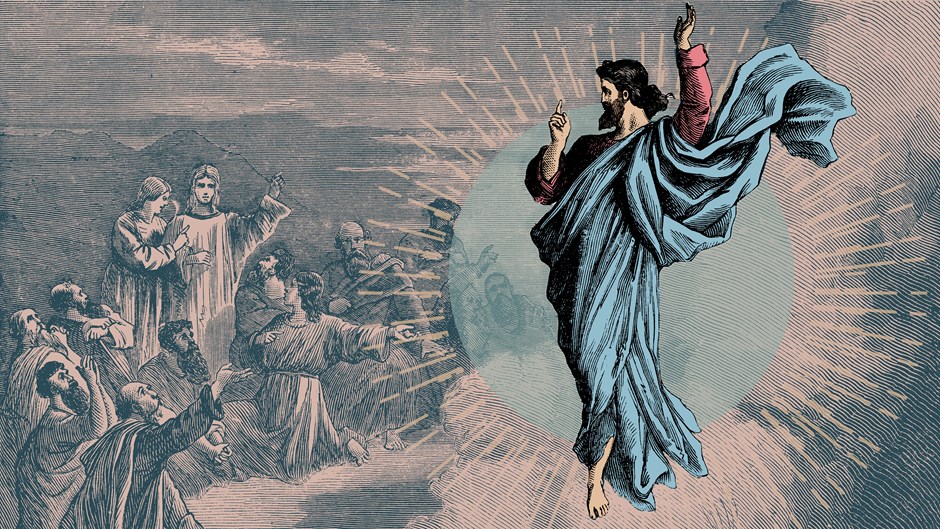50 And he led them out as far as Bethany, and lifting up his hands he blessed them. 51 While he blessed them, he parted from them and was carried up into heaven. 52 And they worshiped him and returned to Jerusalem with great joy, 53 and were continually in the temple blessing God. – Luke 24:50-53 ESV
 Luke is a stickler for details. So, it’s not surprising that he adds a very subtle but significant factor when describing the final moments of Jesus’ earthly ministry. He points out that Jesus led His disciples “out as far as Bethany” (Luke 24:50 ESV). This was the same village, located just a few miles east of Jerusalem, where Jesus had raised Lazarus from the dead. He was returning to the very spot where He had earlier told Martha, the sister of Lazarus, “I am the resurrection and the life. Anyone who believes in me will live, even after dying. Everyone who lives in me and believes in me will never ever die” (John 11:25-26 NLT).
Luke is a stickler for details. So, it’s not surprising that he adds a very subtle but significant factor when describing the final moments of Jesus’ earthly ministry. He points out that Jesus led His disciples “out as far as Bethany” (Luke 24:50 ESV). This was the same village, located just a few miles east of Jerusalem, where Jesus had raised Lazarus from the dead. He was returning to the very spot where He had earlier told Martha, the sister of Lazarus, “I am the resurrection and the life. Anyone who believes in me will live, even after dying. Everyone who lives in me and believes in me will never ever die” (John 11:25-26 NLT).
According to the apostle Paul, between the time Jesus walked out of the tomb to the moment He stood before His disciples in Bethany, He had appeared to hundreds of individuals in His resurrected form.
He was buried, and he was raised from the dead on the third day, just as the Scriptures said. He was seen by Peter and then by the Twelve. After that, he was seen by more than 500 of his followers at one time, most of whom are still alive, though some have died. Then he was seen by James and later by all the apostles. Last of all, as though I had been born at the wrong time, I also saw him. – 1 Corinthians 5:4-8 NLT
So, as He stood among His disciples in Bethany, the scene of Lazarus’ death-to-life transformation, there was little doubt in their minds that He truly was “the resurrection and the life.” He was the literal epicenter for all hope of resurrection. Lazarus had been raised from death to life, but he had not been resurrected. His earthly body had been resuscitated, which is a miracle in and of itself, but he would live to die again. In other words, Lazarus’ new life was nothing more than his old one regained.
But what Jesus had said to Martha regarding the resurrection was something altogether different. He told her, “Everyone who lives in me and believes in me will never ever die” (John 11:26 NLT). To experience the resurrected life was to enjoy eternal life – a never-ending experience of life without pain, suffering, or physical death. It’s fascinating to consider that Jesus chose Bethany the point of departure for His ascension back to heaven. He had a new body that was prepared for its eternal existence with God the Father. Yes, He still retained the scars and visible wounds He had suffered during His crucifixion, but His “earthly tent” had been transformed into into its glorified state. The apostle Paul talked about this “eternal body” and its implications for all believers.
For we know that when this earthly tent we live in is taken down (that is, when we die and leave this earthly body), we will have a house in heaven, an eternal body made for us by God himself and not by human hands. We grow weary in our present bodies, and we long to put on our heavenly bodies like new clothing. For we will put on heavenly bodies; we will not be spirits without bodies. While we live in these earthly bodies, we groan and sigh, but it’s not that we want to die and get rid of these bodies that clothe us. Rather, we want to put on our new bodies so that these dying bodies will be swallowed up by life. God himself has prepared us for this… – 2 Corinthians 5:1-5 NLT
I don’t think it’s farfetched to consider that Lazarus was in the crowd that day. He was a faithful follower of Jesus and was eternally grateful for the miracle of new life that Jesus had given him. But as Lazarus looked on, he was still inhabiting his old earthly tent, while Jesus stood before him in His new “house,” a heavenly body prepared for the joys of eternal life.
For Jesus, the goal was not restored life, but resurrected life. While Judas was living proof that Jesus could raise the physically dead back to life, that had not been His primary objective. New life was not enough. What sinful man really needs is resurrected life. The apostle Paul would drive home this point in his first letter to the believers in Corinth.
…if there is no resurrection of the dead, then Christ has not been raised either. And if Christ has not been raised, then all our preaching is useless, and your faith is useless. – 1 Corinthians 15:13-14 NLT
Belief in a reanimated of a formerly dead Jew was not going to be enough. Jesus wasn’t just another Lazarus – a dead man who had been restored to life. He was the resurrected and glorified Son of God. And it was His resurrection, not His resuscitation that made the difference. Consider what Paul wrote.
…if Christ has not been raised, then your faith is useless and you are still guilty of your sins. In that case, all who have died believing in Christ are lost! And if our hope in Christ is only for this life, we are more to be pitied than anyone in the world. – 1 Corinthians 15:17-19 NLT
The point Paul was trying to make was that Jesus was not simply alive. He is the living hope for all those who have died. His resurrection was not an offer of renewed life on this earth but of eternal life in the coming Kingdom of God. And His resurrection was to stand as a guarantee of all the resurrections to come.
But in fact, Christ has been raised from the dead. He is the first of a great harvest of all who have died. – 1 Corinthians 15:20 NLT
And then, Paul went on to compare Jesus to Adam.
So you see, just as death came into the world through a man, now the resurrection from the dead has begun through another man. Just as everyone dies because we all belong to Adam, everyone who belongs to Christ will be given new life. But there is an order to this resurrection: Christ was raised as the first of the harvest; then all who belong to Christ will be raised when he comes back.– 1 Corinthians 15:21-23 NLT
What’s important to consider is an often overlooked exchange that took place between Jesus and His disciples as they gathered together in Bethany. Luke records this conversation in the opening chapter of the book of Acts.
So when the apostles were with Jesus, they kept asking him, “Lord, has the time come for you to free Israel and restore our kingdom?” – Acts 1:6 NLT
As they stood looking at the resurrected Jesus, all they could think about was the fact that He was alive. Just days earlier, Jesus had been a corpse in a tomb. But now, He stood before them in the peak of health and what they hoped would be full fighting form. Their question reveals that they were still hoping Jesus was going to set up His kingdom on earth. They had not given up hope that Jesus would finally declare His Messiahship by overthrowing the Romans and establishing His reign over Israel. Now that He was alive, there was no time like the present.
But Jesus burst their bubble by announcing, “The Father alone has the authority to set those dates and times, and they are not for you to know. But you will receive power when the Holy Spirit comes upon you. And you will be my witnesses, telling people about me everywhere—in Jerusalem, throughout Judea, in Samaria, and to the ends of the earth” (Acts 1:7-8 NLT).
They had their sights set on a display of military power that would put Israel back on the map. But Jesus promised them a far different kind of power – that which would come from the indwelling of the Holy Spirit. And the only way that kind of power would become available was if the resurrected Jesus returned to His Father’s side. And according to the gospels and the book of Acts, that is exactly what happened.
After saying this, he was taken up into a cloud while they were watching, and they could no longer see him. – Acts 1:9 NLT
…and lifting his hands to heaven, he blessed them. While he was blessing them, he left them and was taken up to heaven. – Luke 24:50-51 NLT
When the Lord Jesus had finished talking with them, he was taken up into heaven and sat down in the place of honor at God’s right hand. – Mark 16:19 NLT
In his gospel account, Luke records that they “worshiped him and then returned to Jerusalem filled with great joy. And they spent all of their time in the Temple, praising God” (Luke 24:52-53 NLT). But it seems that in between the time he wrote his gospel and then penned the book of Acts, Luke had gained further details concerning that fateful day. Through interviews or word of mouth, he discovered that the disciples had experienced one last divine encounter. Two angels had appeared and confronted them about their apparent delay in returning to Jerusalem.
“Men of Galilee,” they said, “why are you standing here staring into heaven? Jesus has been taken from you into heaven, but someday he will return from heaven in the same way you saw him go!” – Acts 1:11 NLT
They were standing there, probably slack-jawed and dumbfounded, as their able-bodied, fully alive Messiah slowly disappeared from sight. They had been hoping He would stay and fulfill all their hopes concerning the Kingdom of God. But He was leaving so that they might one day experience the reality of their own resurrections and the joy of life in His eternal Kingdom. And it was news of His promised return that filled them with joy and sent them back to Jerusalem in a state of heartfelt worship and praise. And we too should rejoice and worship the King for the unwavering promise of His return.
“Surely I am coming soon.” – Revelation 22:20 ESV
English Standard Version (ESV) The Holy Bible, English Standard Version. ESV® Permanent Text Edition® (2016). Copyright © 2001 by Crossway Bibles, a publishing ministry of Good News Publishers.
New Living Translation (NLT) Holy Bible, New Living Translation, copyright © 1996, 2004, 2015 by Tyndale House Foundation. Used by permission of Tyndale House Publishers Inc., Carol Stream, Illinois 60188. All rights reserved.
The Message (MSG)Copyright © 1993, 1994, 1995, 1996, 2000, 2001, 2002 by Eugene H. Peterson



